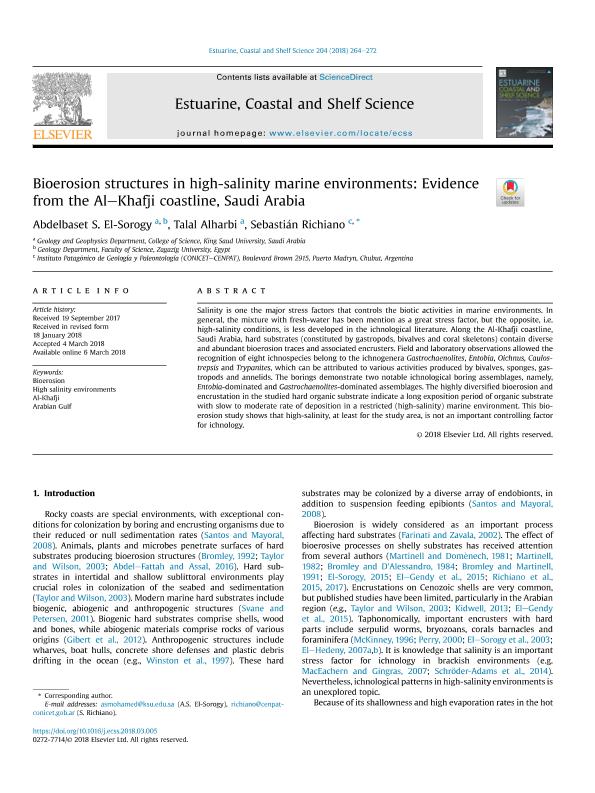Mostrar el registro sencillo del ítem
dc.contributor.author
El Sorogy, Abdelbaset S.
dc.contributor.author
Alharbi, Talal
dc.contributor.author
Richiano, Sebastián Miguel

dc.date.available
2019-10-11T15:09:48Z
dc.date.issued
2018-05
dc.identifier.citation
El Sorogy, Abdelbaset S.; Alharbi, Talal; Richiano, Sebastián Miguel; Bioerosion structures in high-salinity marine environments: Evidence from the Al–Khafji coastline, Saudi Arabia; Academic Press Ltd - Elsevier Science Ltd; Estuarine, Coastal and Shelf Science; 204; 5-2018; 264-272
dc.identifier.issn
0272-7714
dc.identifier.uri
http://hdl.handle.net/11336/85702
dc.description.abstract
Salinity is one the major stress factors that controls the biotic activities in marine environments. In general, the mixture with fresh-water has been mention as a great stress factor, but the opposite, i.e. high-salinity conditions, is less developed in the ichnological literature. Along the Al-Khafji coastline, Saudi Arabia, hard substrates (constituted by gastropods, bivalves and coral skeletons) contain diverse and abundant bioerosion traces and associated encrusters. Field and laboratory observations allowed the recognition of eight ichnospecies belong to the ichnogenera Gastrochaenolites, Entobia, Oichnus, Caulostrepsis and Trypanites, which can be attributed to various activities produced by bivalves, sponges, gastropods and annelids. The borings demonstrate two notable ichnological boring assemblages, namely, Entobia-dominated and Gastrochaenolites-dominated assemblages. The highly diversified bioerosion and encrustation in the studied hard organic substrate indicate a long exposition period of organic substrate with slow to moderate rate of deposition in a restricted (high-salinity) marine environment. This bioerosion study shows that high-salinity, at least for the study area, is not an important controlling factor for ichnology.
dc.format
application/pdf
dc.language.iso
eng
dc.publisher
Academic Press Ltd - Elsevier Science Ltd

dc.rights
info:eu-repo/semantics/openAccess
dc.rights.uri
https://creativecommons.org/licenses/by-nc-nd/2.5/ar/
dc.subject
AL-KHAFJI
dc.subject
ARABIAN GULF
dc.subject
BIOEROSION
dc.subject
HIGH SALINITY ENVIRONMENTS
dc.subject.classification
Paleontología

dc.subject.classification
Ciencias de la Tierra y relacionadas con el Medio Ambiente

dc.subject.classification
CIENCIAS NATURALES Y EXACTAS

dc.title
Bioerosion structures in high-salinity marine environments: Evidence from the Al–Khafji coastline, Saudi Arabia
dc.type
info:eu-repo/semantics/article
dc.type
info:ar-repo/semantics/artículo
dc.type
info:eu-repo/semantics/publishedVersion
dc.date.updated
2019-10-10T13:18:02Z
dc.journal.volume
204
dc.journal.pagination
264-272
dc.journal.pais
Estados Unidos

dc.description.fil
Fil: El Sorogy, Abdelbaset S.. Zagazig University. Faculty of Science. Geology Department; Egipto. King Saud University. College of Science. Geology and Geophysics Department; Arabia Saudita
dc.description.fil
Fil: Alharbi, Talal. Zagazig University. Faculty of Science. Geology Department; Egipto
dc.description.fil
Fil: Richiano, Sebastián Miguel. Consejo Nacional de Investigaciones Científicas y Técnicas. Centro Científico Tecnológico Conicet - Centro Nacional Patagónico. Instituto Patagónico de Geología y Paleontología; Argentina
dc.journal.title
Estuarine, Coastal and Shelf Science

dc.relation.alternativeid
info:eu-repo/semantics/altIdentifier/url/https://www.sciencedirect.com/science/article/pii/S0272771417309149
dc.relation.alternativeid
info:eu-repo/semantics/altIdentifier/doi/http://dx.doi.org/10.1016/j.ecss.2018.03.005
Archivos asociados
